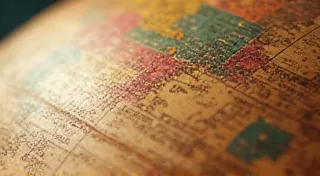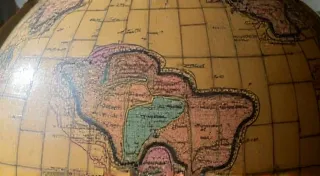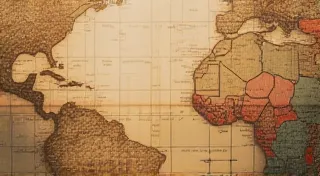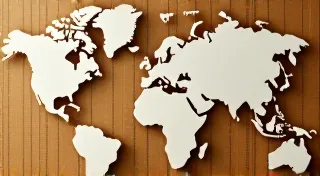Recognizing Fake Antique Globes: Identifying Red Flags
The allure of owning a genuine antique globe is strong, but unfortunately, the market is also rife with fakes and reproductions. Knowing how to spot a fraudulent globe can save you considerable money and disappointment. This guide provides essential tips and techniques to help you authenticate antique globes and avoid globe fraud. While no single factor guarantees authenticity, a combination of these observations will significantly improve your ability to identify a genuine piece. These pieces are not only beautiful objects but also fascinating windows into the cartographic knowledge of past eras.
Paper Quality and Cartography: A Crucial First Look
One of the most common deception techniques involves using modern printing methods and paper to mimic older maps. Early globe maps were hand-drawn and printed using techniques vastly different from today's processes. Reproductions often try to recreate the look of aged paper, but understanding the nuances of antique cartography is key. Here's what to look for:
- Paper Type: Authentic antique globes often have paper that is brittle, discolored (foxing is common, but too *much* foxing can be suspicious depending on age), and has a characteristic feel. Modern paper is generally much smoother and whiter. Feel the paper – a genuine antique globe paper will have a unique texture. Examining paper degradation over time is complex, influenced by factors like storage conditions and paper composition.
- Printing Technique: Examine the printing closely. Early printing techniques produced subtle imperfections, dot patterns, and variations in ink density. Modern printing tends to be too uniform and clean. Look for slight misalignments in the printed map layers. The variations in early printing can be very subtle, requiring a trained eye and good lighting to discern.
- Cartographic Errors & Styles: Genuine antique maps will contain geographical errors reflecting the knowledge of the time. Reproductions often “correct” these errors, which is a major red flag. Research the cartography of the globe’s purported era. Consider the style – does the lettering and map projections match the period? Remember, the appearance of antique globes is often deeply intertwined with the evolution of globe stand restoration techniques and the materials used in their construction, which themselves provide clues to authenticity.
- Modern Inks: While age can change ink color, extremely vibrant or overly dark inks are suspicious, particularly if the paper seems too pristine. The chemical composition of inks has changed significantly over time, and modern inks are often more resistant to fading than their historical counterparts.
Construction and Materials: Beyond the Map
The globe’s overall construction provides vital clues about authenticity. Look beyond just the map itself. The materials and craftsmanship employed significantly influence a globe's value and authenticity. Careful examination can reveal a wealth of information about its origin and age.
- Globe Body Material: Antique globes were often constructed from papier-mâché, wood, or occasionally metal. Check for the type of material indicated by the globe's origin and purported date. A globe claiming to be from the 18th century made of plastic is immediately suspect. The condition of these materials can also provide further clues about the globe's history.
- Meridian and Stand: The meridian (the ring around the globe) and stand are important elements. The materials and construction should be consistent with the globe's purported age and origin. Examine joinery – hand-carved details are characteristic of older construction. Many antique globes benefited from dedicated globe stand restoration work to preserve their structural integrity, so examining the stand’s age and treatment can offer insights.
- Seam Lines & Construction Details: Modern reproductions are often seamlessly constructed. Genuine antique globes often show visible seams where the gores (the segments of the globe) are joined. These seams may be patched or repaired, but their presence is generally a sign of age. The technique used to join the gores can also be indicative of the globe’s origin and era.
- Finish and Patina: A genuine antique globe will have a patina - a subtle accumulation of age-related changes to the finish. A perfectly pristine finish on a globe claiming to be 150 years old is highly unlikely. The patina is a result of the interaction of the globe's surface with the environment over time.
Dating and Provenance: Building a History
Determining the age and origin of an antique globe is challenging, even for experts. However, gathering information about the globe’s provenance (history of ownership) can add credibility. Tracing a globe's history can be a complex process, requiring research and detective work. The more information available about a globe's past, the more likely it is to be considered authentic.
- Original Labels/Markings: Look for any original labels, markings, or maker's marks. Research these markings to verify their authenticity and connection to the globe’s purported origin. These marks can provide valuable clues about the globe's maker, origin, and date of manufacture.
- Historical Documentation: Any documentation related to the globe's history – old invoices, auction records, or family histories – can be invaluable in establishing its authenticity. These documents provide tangible evidence of the globe's existence and history.
- Expert Consultation: When in doubt, consult with a reputable antique globe expert or appraiser. They have the experience and knowledge to identify subtle clues that might be missed by the untrained eye. Expert opinions can provide valuable insights and help to avoid costly mistakes.
Common Red Flags: Quick Checks
Here's a handy summary of immediate warning signs:
- Perfect Condition: Globes rarely survive in flawless condition. The ravages of time almost always leave their mark.
- Modern Materials: Plastic, bright synthetic finishes – a clear indicator of a reproduction.
- Corrected Cartography: Absence of known geographical inaccuracies – a significant red flag.
- Uniform Printing: Lack of imperfections and variations in ink density – a hallmark of modern printing techniques.
- Lack of Provenance: No history or documentation to support its age – a cause for serious doubt.





